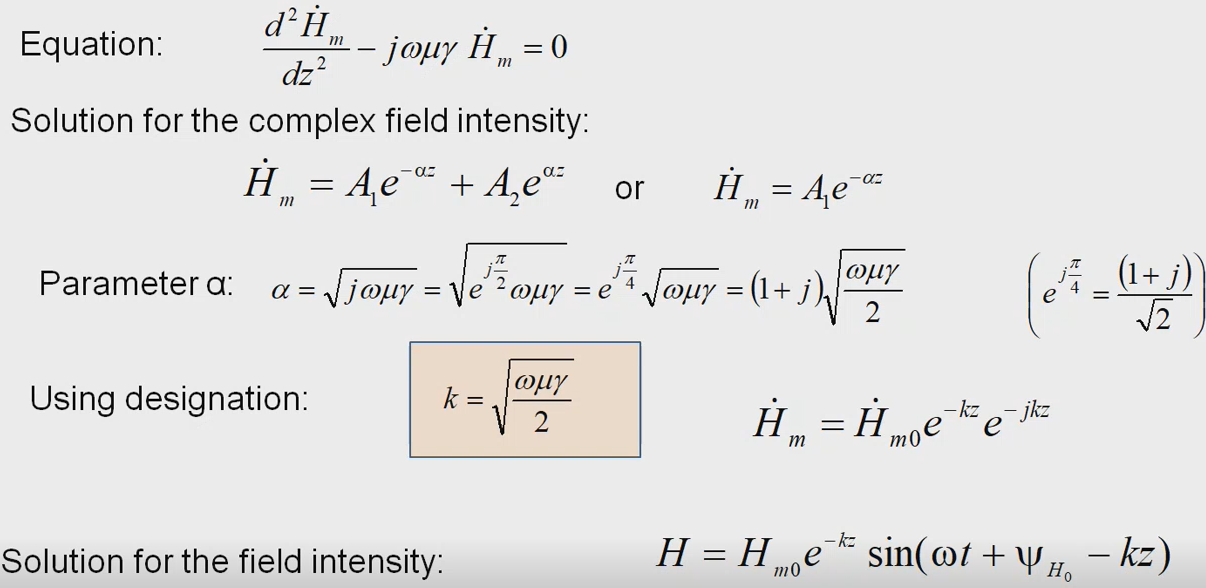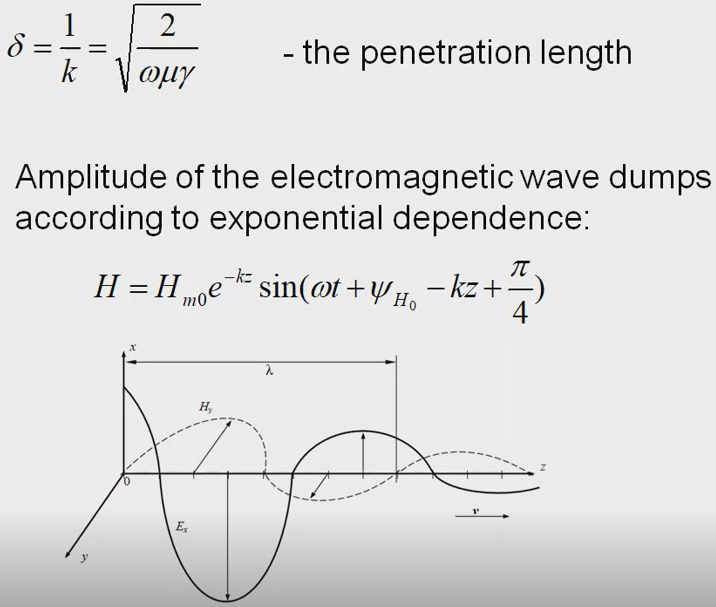
- •Лекция 1. Fundamental concepts of electromagnetics. Electrostatics. (Начало электростатики)
- •Vectors and scalar fields. (Векторные и скалярные поля)
- •Electrostatic field. (Электростатическое поле)
- •Coulomb’s Law. (Закон Кулона)
- •Electric Field Strength e and Displacement Field d. (Напряжённость и смещение электрического поля)
- •Gauss’ Law. (Закон Гаусса)
- •Electric Potential. (Электрический потенциал)
- •Work in the electric field. (Работа в электрическом поле)
- •Dielectric polarization. (Диэлектрическая поляризация)
- •Dielectric material characteristics. (Характеристики диэлектриков)
- •Properties of dielectric materials. (Свойства диэлектрических материалов)
- •Poisson’s and Laplace’ s equations. (Уравнения Пуассона и Лапласа)
- •Лекция 2. Boundary conditions for the Laplace or Poisson equations (Граничные уравнения для уравнений Лапласа и Пуассона)
- •Electrostatic Energy (Электростатическая энергия)
- •Virtual experiment. (Эксперимент по нахождению энергии системы)
- •Consequences (Следствия)
- •Continuity Equation (Уравнение непрерывности)
- •Лекция 3. Static magnetic field (Статическое магнитное поле)
- •Variables and units (Переменные и единицы измерения)
- •Main Relations (Основные соотношения)
- •Magnetic flux density (Индукция магнитного поля)
- •Biot-Savart’s law (Закон Био-Савара)
- •Ampere’s law (Закон полного тока)
- •Scalar magnetic potential (Скалярный магнитный потенциал)
- •The cut in the space (Разрез в пространстве)
- •Laplace equation for the scalar magnetic potential (Уравнение Лапласа для скалярного магнитного потенциала)
- •Vector magnetic potential (Векторный магнитный потенциал)
- •Magnetic flux (Магнитный поток)
- •Differential equation for the vector magnetic potential (Дифференциальное уравнение для векторного магнитного потенциала)
- •Gauging of the vector magnetic potential (Калибровка векторного магнитного потенциала)
- •Integral presentation of the vector magnetic potential (Интегральное представление векторного потенциала)
- •Inductance (Индуктивность)
- •Mutual inductance (Взаимная индуктивность)
- •Inductance of thin contours (Индуктивность тонких контуров)
- •Field intensity inside a cylindrical conductor (Напряжённость поля внутри цилиндрического проводника)
- •Лекция 4. Method of images (метод зеркальных изображений)
- •Equivalent charge density (эквивалентная плотность заряда)
- •Method of images for cylindrical boundaries between dielectrics (метод изображений цилиндрических границ между диэлектриками) Problem formulation (постановка задачи)
- •The inverse point (обратная точка)
- •Normal component of the field intensity (нормальная составляющая напряжённости поля)
- •Geometrical relations (геометрические соотношения)
- •Angles (углы)
- •Field induced by the line sources (поле, индуцированное линейными источниками)
- •The field sources for the external domain (источники полей для внешней области)
- •The field sources for the internal domain (источники полей для внутренней области)
- •Image method for the flat boundary between magnetic media (Метод изображений для плоской границы между магнитными носителями)
- •Equivalent magnetic charge density (Эквивалентная плотность магнитного заряда)
- •Dependence of the field intensity on the coordinate (Зависимость напряжённости поля от координаты)
- •Inductance of the two-wire transmission line per unit length (Индуктивность двухпроводной линии передачи на единицу длины)
- •Total inductance (Общая индуктивность)
- •Forces. The first line. (Силы. 1ая линия)
- •Forces. The second line. (Силы. 2ая линия)
- •Лекция 5. Solution of Laplace’s equation by separation of variables. (Решение уравнения Лапласа методом разделения переменных) Application of Laplace’s equation (Применение уравнения Лапласа).
- •Choice of a coordinate system (Выбор системы координат)
- •Variable separation in cylindrical coordinates (Разделение переменных в цилиндрических координатах)
- •Angular function (Угловая функция)
- •Radial function (Радиальная функция)
- •General solution of the Laplace’s equation in a cylindrical coordinate system (Общее решение уравнения Лапласа в цилиндрической системе координат)
- •Application of the variable separation method for the magnetic field modeling (Применение метода разделения переменных для моделирования магнитного поля)
- •Reduced scalar magnetic potential (Редуцированный скалярный магнитный потенциал)
- •Combination of scalar magnetic potential and reduced magnetic potential (Комбинация скалярного магнитного потенциала и редуцированного магнитного потенциала)
- •The scalar potential induced by the current line (Скалярный потенциал, индуцируемый линией тока)
- •The current potential in the cylindrical coordinate system (Потенциал от линии с током в цилиндрической системе координат)
- •The current potential in the complex plane (Потенциал от линии с током в комплексной плоскости)
- •Expansion of the current potential in the cylindrical coordinate system (Разложение потенциала от линии с током в цилиндрической системе координат)
- •Potentials in the problem domain (Потенциалы в проблемной области)
- •Inductance of the two-wire transmission line per unit length (Индуктивность двухпроводной линии передачи на единицу длины)
- •The flux induced by the magnetized cylinder (Поток, индуцируемый намагниченным цилиндром)
- •Лекция 6. Time dependent electromagnetic fields (Зависящие от времени электрические поля)
- •Faraday’s Law (Закон электромагнитной индукции)
- •Lenz’s Law (правило Ленца)
- •Induction by a temporal change of b (Индукция за счёт временного изменения b)
- •Induction through the motion of the conductor (Индукция за счёт движения проводника)
- •Induction by simultaneous temporal change of b and motion of the conductor (Индукция одновременным изменением во времени b и движением проводника)
- •Unipolar generator (Униполярный генератор)
- •Hering’s paradox (Парадокс Геринга)
- •Periodic electromagnetic field in the conductors. (Периодическое электромагнитное поле в проводниках)
- •Penetration of the electromagnetic field into a conductor. (Проникновение электромагнитного поля в проводник)
- •The skin effect. (Скин-эффект)
- •Poynting’s Theorem. (Теорема Пойнтинга) Electromagnetic Field Energy. (Энергия электромагнитного поля)
- •The rate of decrease of the electromagnetic field energy in a closed volume. (Скорость уменьшения энергии электромагнитного поля в замкнутом объёме)
- •Energy flows in the electromagnetic field (Поток энергии в электромагнитном поле)
- •Transmission of energy in a dc line (Передача энергии в линиях постоянного тока)
- •Transmission of energy in a dc line (Передача энергии в линиях постоянного тока)
- •The field picture near the wires with current (Картина поля вблизи провода с током)
- •Energy flows in static fields (Поток энергии в статических полях)
- •The momentum of the electromagnetic field (Момент электромагнитного поля)
- •The momentum of the electromagnetic field (Момент электромагнитного поля)
- •Лекция 8. Numerical Methods of the Electromagnetic Field Modeling. (Численные методы моделирования электромагнитного поля) Classification of the numerical methods (Классификация численных методов)
- •Classification of the problems (Классификация проблем)
- •Classification of the methods (Классификация методов)
- •Method of moments (Метод моментов)
- •Discretization of the problem domain (Дискретизация проблемной области)
- •Algebraic equation system (Алгебраическая система уравнений)
- •Finite element method (Метод конечных элементов)
- •Discretization (Дискретизация)
- •Finite functions (Ограниченная функция – отлична от нуля только в пределах треугольника)
- •Approximation of functions inside triangles (Аппроксимация функций внутри треугольника)
- •Approximation of the equation (Аппроксимация уравнения)
- •Weighted residual method (метод взвешенных невязок)
- •Galerkin method (метод Бубнова-Галеркина)
- •Weak formulation (ослабленная формулировка)
- •First type boundary conditions (Первый тип граничных условий)
- •The potential and field intensity (Потенциал и напряжённость поля)
Periodic electromagnetic field in the conductors. (Периодическое электромагнитное поле в проводниках)
These approaches are very important form of existence of electromagnetic field – electromagnetic wave. That’s the case when the electric field intensity or magnetic field intensity depends on time according to sinusoidal function:
Quasi-stationary approaches:![]()
The electromagnetic field is often called a planner electromagnetic wave. To describe it let’s use the complex method (using to describe currents and voltage in electromagnetic circuits):


On the picture: in the left part γ is equal to 0, so electromagnetic wave comes from somewhere to this planner surface and then it starts to penetrate the conducting material (metal):
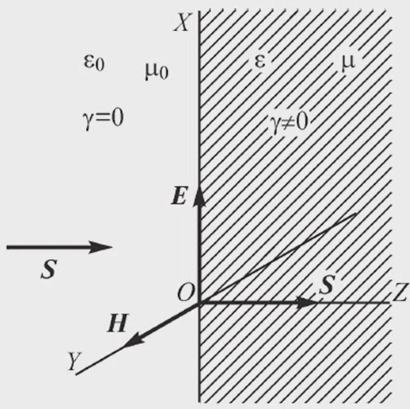
Equation: |
|
Solution for the complex field intensity: |
|
Parameter α: |
|
Using designation: |
|
Solution for the field intensity: |
|
( ,
because: decreases, when we are travelling into the conducting medium
and field intensity is growing to infinity)
,
because: decreases, when we are travelling into the conducting medium
and field intensity is growing to infinity)
Penetration of the electromagnetic field into a conductor. (Проникновение электромагнитного поля в проводник)
Everywhere inside the conductor the magnetic field intensity will be oscillating function, but the amplitude of this oscillation will be less and less:
The penetration length: |
|
Amplitude of the electromagnetic wave dumps according to exponential dependence:
The skin effect. (Скин-эффект)
The maximum value of the amplitude of the electromagnetic field corresponds to the left and right side of the conducting plate. When we move into the center of the conducting plate, the magnetic field decreases, and the amplitude become smaller and smaller. In the center the disappearing is almost completes.
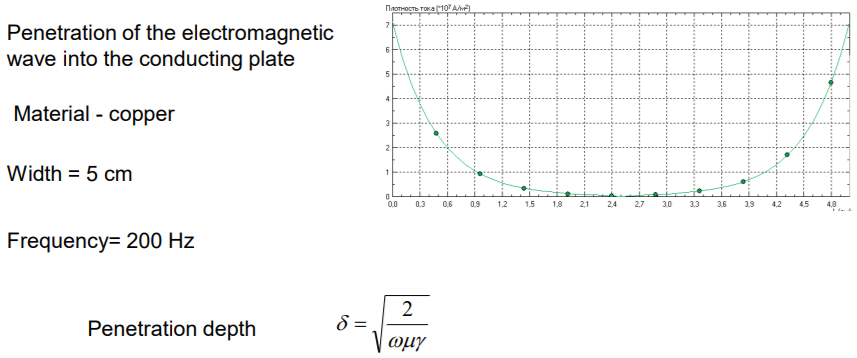
Penetration depth:
Penetration length – it’s the position where the amplitude decreases by the e=2.73
Poynting’s Theorem. (Теорема Пойнтинга) Electromagnetic Field Energy. (Энергия электромагнитного поля)
The energy of the electromagnetic field enclosed inside a certain volume V, bounded by a closed surface S, is determined by the volume energy density of the electric and magnetic fields.
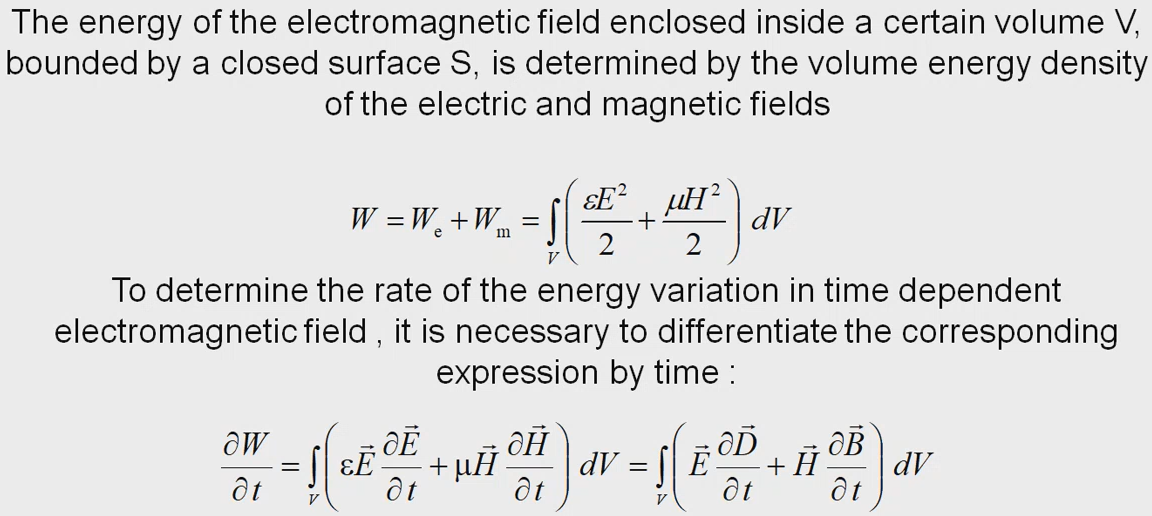
To determine the rate of the energy variation in time dependent electromagnetic field, it is necessary to differentiate the corresponding expression by time:
The rate of decrease of the electromagnetic field energy in a closed volume. (Скорость уменьшения энергии электромагнитного поля в замкнутом объёме)
The main relations between the characteristics of the electromagnetic field:
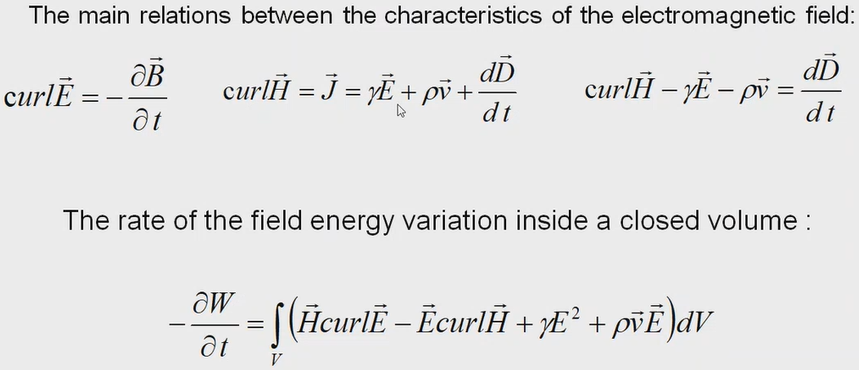
The rate of the field energy variation inside a closed volume:
The volume of divergence of any vector may be replaced by the integral of the closed surface of this volume.
Using the algebra formula
![]() ,
we get:
,
we get:
After applying the Gauss theorem:
The resulting expression is called the Poynting’s theorem.
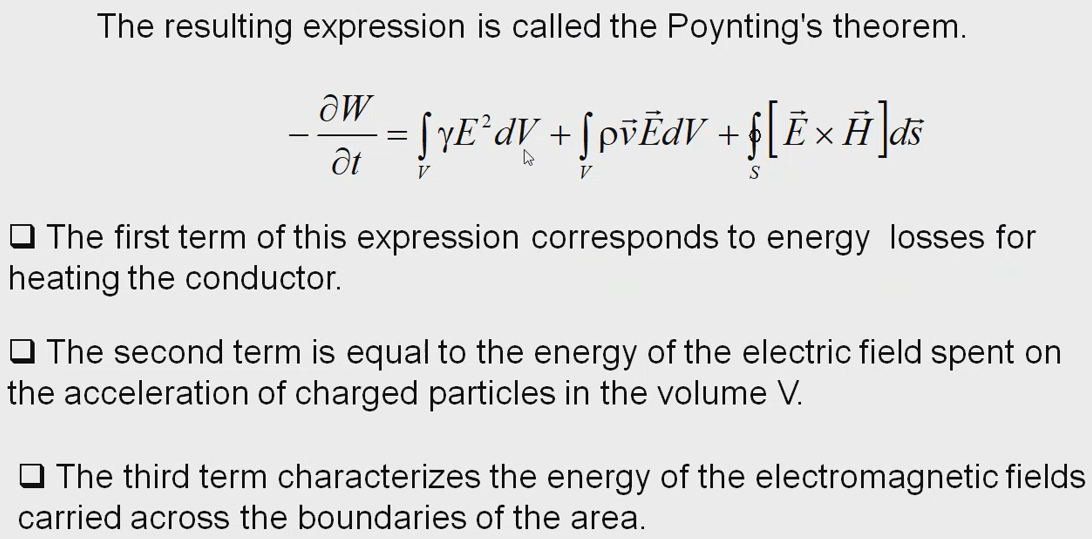
The first term of this expression corresponds to energy losses for heating the conductor.
The second term is equal to the energy of the electric field spent on the acceleration of charged particles in the volume V.
The third term characterizes the energy of the electromagnetic fields carries across the boundaries of the area.
The power of radiated electromagnetic energy is numerically equal to the flow of energy through the surface per unit of time.
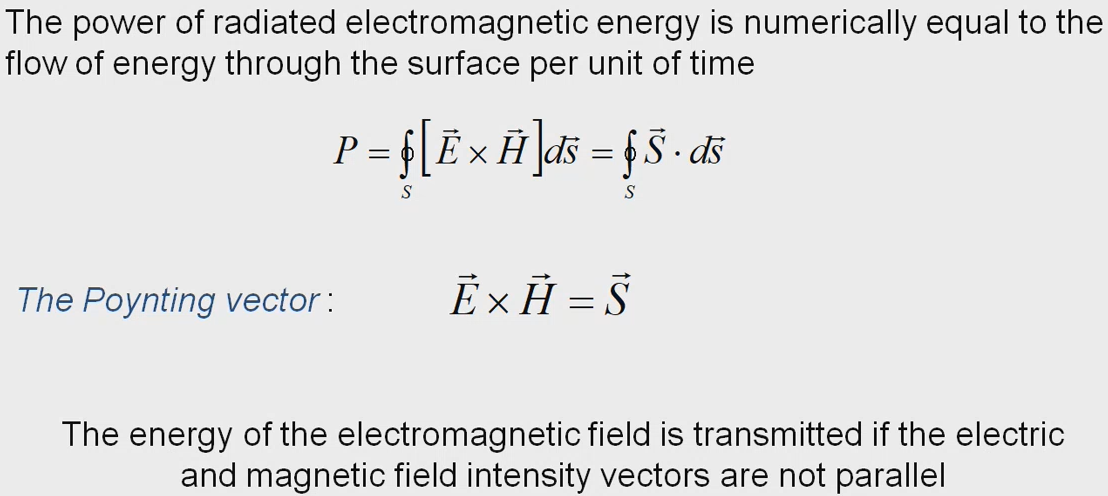
The Poynting vector:
The energy of the electromagnetic field is transmitted if the electric and magnetic intensity vectors are nor parallel.

